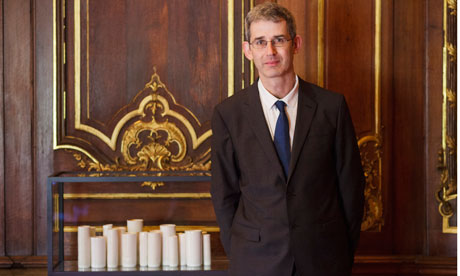
They came from a studio in a less than glamorous part of south London between a Betfred, a takeaway and a car repair shop and are now in one of the most astonishingly opulent houses in England, nestling between Reynolds paintings, Sèvres porcelain and gilt furniture.
"It is kind of hilarious," admitted the ceramic artist Edmund de Waal. "To leave Tulse Hill in a van and come here is in a way pure comedy."
De Waal has created well over a thousand porcelain pots and installed them in the breathtaking interiors of Waddesdon, the grand Rothschild house near Aylesbury in Buckinghamshire.
The artist might be best known to some as the author of the internationally bestselling memoir The Hare with Amber Eyes, now translated into more than 18 languages. That book, which won the Costa biography award, saw the author using his inheritance of 264 Japanese netsuke from his great-uncle Iggie to trace the fortunes of his ancestors, the Ephrussis, one of the richest of Europe's Jewish banking families.
There are many resonances between the book and the exhibition. "It would be mawkish to say it is the exhibition of the book," said De Waal. "But it is the exhibition I could only do because I had written the book."
De Waal has placed pots in vitrines in some of the house's grandest rooms. For example, in a breakfast room they are opposite stunning Meissen animal figures – a nanny goat and turkey – that were made for Augustus the Strong's Japanese palace in 1732. In a morning room they are under Joshua Reynolds's magnificent painting of Thaïs. They are stunningly beautiful but you could easily not even realise they were there.
That is deliberate. "The idea is that the objects sit in the house and on furniture and float," he said. "They are in the place, but not of the place."
For the first time in his work De Waal is using vitrines – all quite minimal and contemporary looking.
De Waal said the exhibition came after a double invitation from a curator at Waddesdon and from Lord Rothschild himself to do something interpretive in the house. "They were pushing at an open door," he said. "There was no door."
It is a deeply personal project that has occupied De Waal for a good year and a half. "It has been a really tough 18 months because it matters so much to me to work with real integrity here and do something that was really new. I wanted to do something that was completely embedded in this house, that responded with real tact to the sensitivity of this place."
After the global success of his book, he admitted it was a relief to be back making pots. "I spent a terrible year on the road, which was wonderful obviously and I'm very fortunate – but it was a punishing year, so this has been my way back into the studio. It has felt very good."
Some of the vitrines are frosted, which reflects a kind of loss in that Waddesdon is perhaps the only big house of one of the old Jewish banking families with its contents still intact. "They have a ghostly presence and are there to signify moments of loss – of houses, objects and people."
There is also a heavy sense of dispersal in terms of where all the vitrines have been placed around the house.
De Waal's ancestors, the Ehphrussi family, and the Rothschilds moved and married in similar circles. There are "lots of cousins", said De Waal.
The show is on at a house that would take most people's breath away. It was built from 1874 by Baron Ferdinand de Rothschild to show off and house his vast collection of French furniture, Dutch old masters and English portraits. Just getting to it requires a five-minute drive through one of the finest Victorian gardens in England. It was bequeathed to the National Trust in 1957 and is now one of its most visited historic houses.
• Edmund de Waal's work is at Waddesdon until 28 October.

